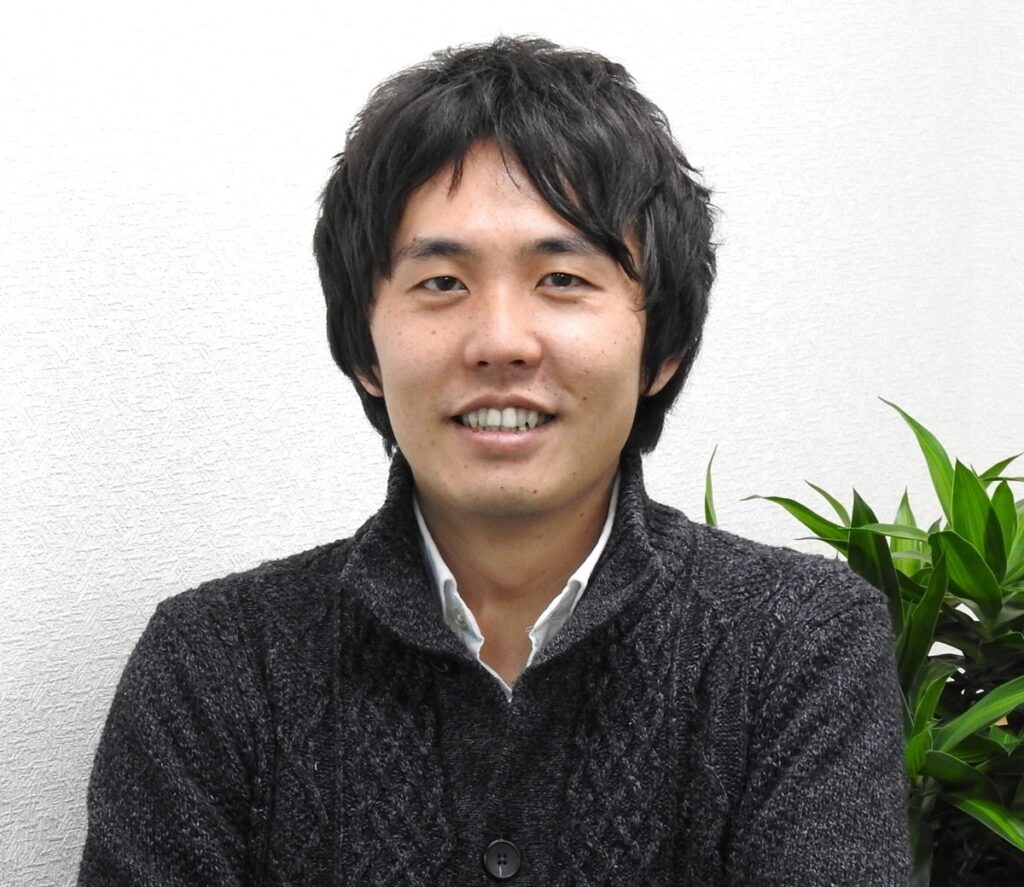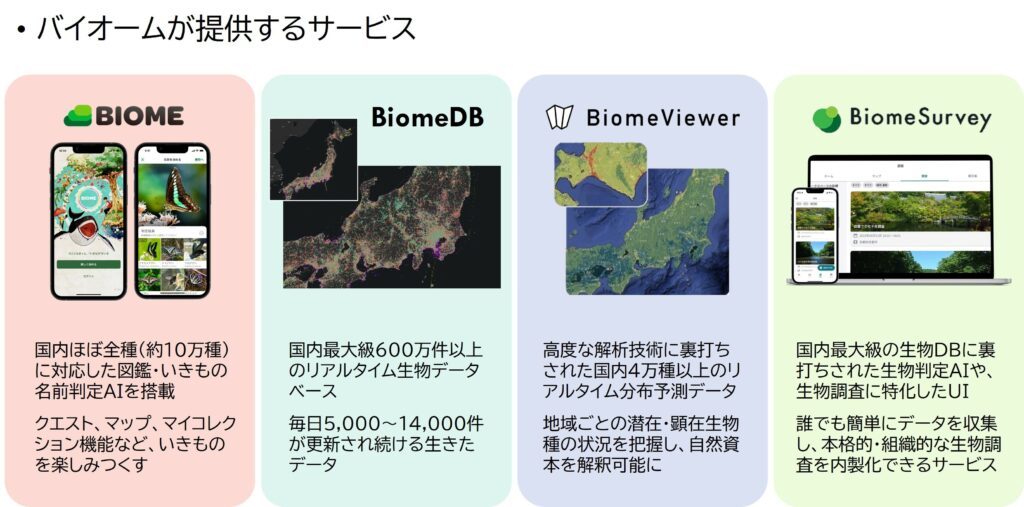Mr. Shogoro Fujiki, CEO of Biome Inc.
When he was a student, Mr. Shogoro Fujiki, the CEO of Biome Inc., spent his life doing research in the jungles of Borneo Island, where environmental destruction was becoming increasingly severe. He became convinced that the issue of environmental conservation could not be resolved unless it was compatible with economic activities. He set his eyes on more than 4 billion smartphones being used around the world and developed the Biome app which monitors biodiversity. His business has then become a hot topic. We talked with him about his experiences that inspired the development of the app as well as his future plans.

―You started Biome Inc. in 2017, just after completing your graduate study. How did you decide to start your own business?
I was originally a forest ecologist at Kyoto University, where I kept researching on the topic of ecology and biodiversity. Through the various experiences that I faced at that time, I became acutely aware of the necessity of making biodiversity conservation a viable business. When I obtained my PhD, I started my company as a startup from Kyoto University.
―What were your experiences that convinced you of the necessity of making biodiversity conservation a viable business?
When I was a student, I spent about two years camping out on the island of Borneo, which is said to be a treasure trove of biodiversity. Borneo consists territories of three countries, Indonesia, Malaysia, and Brunei. The island has vast and wonderful jungles (rainforest areas) with tall trees more than 60 meters high, equivalent to a 20-story building, growing everywhere.
However, some areas on Borneo Island that used to be jungles had only grass at that time, so that I could see all the way to the horizon. All the trees that were supposed to be there had been gone.
―They were cut down by humans, right?
That’s right. Rather than finding areas like that, most of the land had already been deforested. When I realized that, I felt that something outrageous was happening. It’s said that the loss of biodiversity is one of the risks that could lead to the most serious damage to our planet and society in the next 10 years. In order to stop this, we must fight against the strong desire to simply pursue economic profit.
―Fighting against the strong desire to pursue profit?
People try to make money by cutting big trees and planting profitable rubber trees. Everyone wants money. If that’s the case, it’s difficult to solve this problem with an approach like research or volunteering. I felt that I must create a system that would allow people to make money by conserving the environment so that the strong desire to pursue profit could be directed to environmental conservation.
―So as soon as you finished graduate school, you started a business as a joint stock company, right?
My idea was that if we succeeded, we could provide a model case that allows people to think that they can surely make money by conserving the environment.
―You said that your research at university and experiences in Borneo Island had inspired you to start the company. In the first place, what made you so interested in biodiversity that you decided to research on the topic at university?
Actually, it was an exotic fish, bluegill. When I was in elementary school, I really liked fishing and used to fish for crucian carp in nearby ponds and rivers where fishing was allowed. Since one day, I started to catch only bluegill in the same place. Even as a child, I felt uneasy, thinking that how this happened. I think that was the origin of my interest in the environment.
―A boy who wondered why his crucian carp fishing turned into bluegill fishing before he knew it decided to start a business for the purpose of environmental conservation through impactful experiences in Borneo. What an interesting story! Could you tell us more details of the business?
Unlike emission controls or carbon dioxide emission allowances, issues in environmental conservation were very difficult to quantify, which was a problem. The situation of organisms is completely different from place to place, so quantification doesn’t make sense unless the local situation is taken into account. So we decided that we need an platform that could industriously collect all information about organisms everywhere.
―That’s where the smartphone app came in.
Smartphones are a great device with more than 4 billion units in the world today. There is no better choice than using smartphones to realize our business idea. So we created the creature collection app Biome. It is powered by AI that can identify the names of creatures when the user takes pictures of them. The app collects creatures with the help of its users who take pictures of various creatures they find and post them along with the species names. You can think of this like a realistic version of Pokemon Go.

―You aimed to create an app that individuals could enjoy, right?
Yes. Currently, the app has 890,000 users and collects about 5,000 to 14,000 pictures of creatures in a stream every day. Since information is collected from all over Japan every day, we now have far more real-time data than the country does.
―It is a huge accumulation of data.
We also created BiomeSurvey, an app dedicated to biological research, so that we are accumulating more detailed data on creatures every day. We can now create maps that can visualize the diversity of organisms, which couldn’t be quantified before.
―What can we do with that data?
For example, you can create a real-time map that shows the habitat of a creature, much like the sense of a weather forecast map. You can also make detailed estimates of creatures listed in different places, which makes it easier and more efficient to know which areas to conserve and create plans for them.
Now that we can finally quantify and visualize biodiversity, we can also use our data to provide support to companies so that they can respond to the Task Force on Nature-related Financial Disclosures (TNFD), an international framework that requires financial institutions and companies to disclose business opportunities and risks in terms of natural capital and biodiversity.
―I heard that your data analysis has already been put into practical use in many cases.
That’s right. For example, we can grasp the distribution of organisms and issue an alert immediately when an alien species comes in and then remove it. We can also predict the distribution of animals designated as harmful species. Furthermore, we can support airport screening to prevent the smuggling of rare species by using AI to identify the names of organisms.
Since our starting point was that motivation won’t last without profit, we want to use this database and analysis technology effectively to develop our business to keep the economy moving forward while conserving the environment.
―You and your business have already attracted a lot of attention and have been collaborating with major companies, government agencies, universities, and others. I also heard you have conducted more than 300 conservation projects so far.
We have been collaborating with industry, government, academia, and the private sector in efforts to contribute to the conservation of biodiversity. Last year, for example, we assisted in the planning and operation of a biological survey event hosted by Mitsubishi Estate Co., Ltd. We have also teamed up with many other companies, including Aeon Co., Ltd., Tokyu Land Corporation, three Japan Railway (JR) companies, and major telecommunications companies. In addition, we also collaborate with public organizations, such as the Ministry of the Environment, the National Institute for Environmental Studies, Tokyo Metropolitan Government, Kobe City Government, Adachi (Tokyo) Ward Government, and Kochi City Government, as well as educational institutions, such as Kyoto University, Kyoto Sangyo University, and Niigata University, by providing data for them and conducting monitoring (surveys).
Through these efforts, we have come to realize how our big data can be used for economic activities by linking it with public events, ecotourism, organizational branding, urban planning, and others that are aimed at environmental conservation.
―It seems that you have gained momentum to make a leap from data on a smartphone app that individuals can enjoy like a game to the creation of a platform that can hold the future of the planet. Finally, please tell us about your plans for the future.
We aim for natural revival, halting and reversing the loss of biodiversity from a nature-positive perspective. We believe it is time now to significantly accelerate the development of biodiversity market. To this end, it’s essential to build up appealing examples that everyone wants to follow. If any company is interested in or have any thoughts or concerns about these topics, please feel free to contact us.
| Company name:Biome Inc. |
| Founded:May 2017 |
| Number of employees:45(including part-time workers) |
| Main business:Operating a biological information platform and developing and operating biological apps URL:https://biome.co.jp/en/ |
This article is part of a series of articles introducing venture companies working together as ICF members to resolve societal issues.





